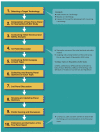An XYZ-axis Matrix Approach for the Integration of Neuroscience and Neuroethics
- PMID: 36919332
- PMCID: PMC10017846
- DOI: 10.5607/en22032
An XYZ-axis Matrix Approach for the Integration of Neuroscience and Neuroethics
Abstract
The recent, unprecedented advancement in neuroscience has led to new discoveries about the human brain and its function. Yet at the same time, it has spurred novel ethical and regulatory issues, and the field of neuroethics has emerged as an interdisciplinary endeavor to address these issues. Across the globe, extensive efforts have been underway to achieve the integration of neuroscience and Neuroethics, with active engagement not only from academia but also from the government, the public, and industry. However, in some countries, integrating neuroscience and neuroethics has proved to be a particularly challenging task. For example, in South Korea, the government has primarily driven the integration effort, and only a small group of researchers is properly trained for conducting an interdisciplinary evaluation of ethical, legal, social, and cultural implications (ELSCI) of neurotechnology. On the basis of the last few years of experience pursuing a government-funded neuroethics project in South Korea, we developed a new operational framework to provide practical guidance on ELSCI research. This framework consists of the X, Y, and Z axes; the X-axis represents a target neurotechnology, the Y-axis represents different developmental stages of the technology, and the Z-axis represents ELSCI issues that may arise from the development and use of the neurotechnology. Here we also present a step-by-step workflow to apply this matrix framework, from organizing a panel for a target neurotechnology to facilitating stakeholder discussion through public hearings. This framework will enable meaningful integration of neuroscience and neuroethics to promote responsible innovation in neuroscience and neurotechnology.
Keywords: Ethics; Neuroscience; Social integration; Three-dimensional.
Figures




References
-
- Walker AE. A history of neurological surgery. Hafner; New York, NY: 1967. pp. 1–50.
-
- Delgado JMR. Physical control of the mind toward a psychocivilized society. Harper & Row; New York, NY: 1971.
-
- Dworkin G. Acting freely. Noûs. 1970;4:367–383. doi: 10.2307/2214680. - DOI

